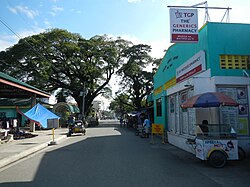Infanta | |
|---|---|
| Municipality of Infanta | |
 Downtown area | |
| Motto: Spherm Shell Delos Reyes | |
 Map of Pangasinan with Infanta highlighted | |
Location within the Philippines | |
| Coordinates: 15°49′15″N119°54′30″E / 15.82083°N 119.90833°E | |
| Country | Philippines |
| Region | Ilocos Region |
| Province | Pangasinan |
| District | 1st district |
| Founded | October 4, 1876 |
| Named after | Isabella II of Spain [1] |
| Barangays | 13 (see Barangays) |
| Government | |
| • Type | Sangguniang Bayan |
| • Mayor | Marvin M. Martinez |
| • Vice Mayor | Virgilio F. Vallarta |
| • Representative | Arnold D. Celeste |
| • Municipal Council | Members |
| • Electorate | 18,476 voters (2025) |
| Area | |
• Total | 254.29 km2 (98.18 sq mi) |
| Highest elevation | 163 m (535 ft) |
| Lowest elevation | 0 m (0 ft) |
| Population (2024 census) [4] | |
• Total | 26,837 |
| • Density | 105.54/km2 (273.34/sq mi) |
| • Households | 6,460 |
| Economy | |
| • Income class | 3rd municipal income class |
| • Poverty incidence | 21.03 |
| • Revenue | ₱ 224.7 million (2022) |
| • Assets | ₱ 488.4 million (2022) |
| • Expenditure | ₱ 168.7 million (2022) |
| • Liabilities | ₱ 110.2 million (2022) |
| Service provider | |
| • Electricity | Pangasinan 1 Electric Cooperative (PANELCO 1) |
| Time zone | UTC+8 (PST) |
| ZIP code | 2412 |
| PSGC | |
| IDD : area code | +63 (0)75 |
| Native languages | Pangasinan Sambal Ilocano Tagalog |
| Website | infantapangasinan |
Infanta, officially the Municipality of Infanta (Pangasinan : Baley na Infanta; Ilocano : Ili ti Infanta; Sambal : Babali nin Infanta; Filipino : Bayan ng Infanta), is a municipality in the province of Pangasinan, Philippines. According to the 2024 census, it has a population of 26,837 people. [6]




